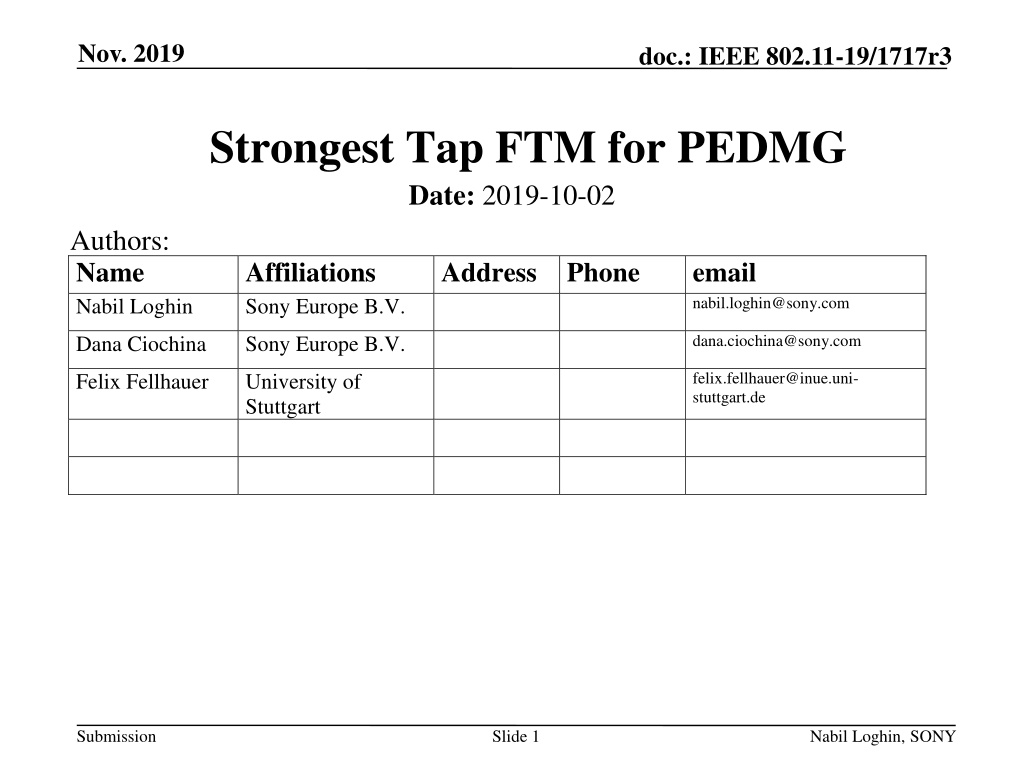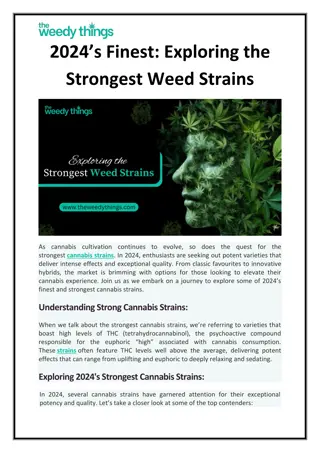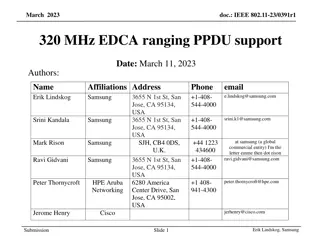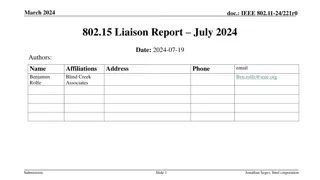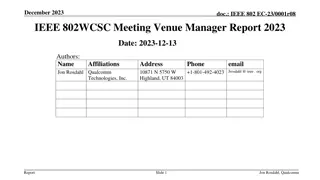IEEE 802.11-19 Presentation on Strongest Tap FTM for PEDMG
Presentation on utilizing FTM measurements for the strongest arrival path in obstructed LOS scenarios, focusing on clock offset estimation, precise synchronization for wireless speakers, and positioning enhancement. The proposed method aims to exploit both best and first path information to localize and solve angular references, improving accuracy and solving overdetermined equations for LOS/NLOS discrimination.
Uploaded on Sep 25, 2024 | 0 Views
Download Presentation

Please find below an Image/Link to download the presentation.
The content on the website is provided AS IS for your information and personal use only. It may not be sold, licensed, or shared on other websites without obtaining consent from the author. Download presentation by click this link. If you encounter any issues during the download, it is possible that the publisher has removed the file from their server.
E N D
Presentation Transcript
Nov. 2019 doc.: IEEE 802.11-19/1717r3 Strongest Tap FTM for PEDMG Date: 2019-10-02 Authors: Name Nabil Loghin Affiliations Sony Europe B.V. Address Phone email nabil.loghin@sony.com dana.ciochina@sony.com Dana Ciochina Sony Europe B.V. felix.fellhauer@inue.uni- stuttgart.de Felix Fellhauer University of Stuttgart Submission Slide 1 Nabil Loghin, SONY
Oct. 2019 doc.: IEEE 802.11-19/1717r3 Abstract The presentation covers comments open CIDs FTM measurement for strongest CIR tap for PEDMG excluding PDMG, due to limited use-cases (no first path AWV) CID #: 1427: R2I / I2R ToA Type to distinguish b/w first vs. strongest tap FTM 2349: option to include strongest tap FTM with new trigger field 5 This presentations shows the motivation behind these comments and proposes corresponding resolutions Submission Slide 2 Nabil Loghin, SONY
Oct. 2019 doc.: IEEE 802.11-19/1717r3 Motivation ToA and optionally AOA/AOD measurements of strongest arrival path (tap) of the CIR may be required for precise clock offset estimation in obstructed LOS (oLOS) scenarios, e.g., for sync of wireless speakers synchronization of multiple wireless speakers in oLOS scenario strongest tap FTM provides higher SNR more precise synchronization enhanced positioning in oLOS scenario in addition to First Path measurements perform FTM based on strongest arrival path unknown reflector position, but additional AOA/AOD/ToA measurements solve overdetermined system of equations (see next slides) ~ 25% accuracy improvement simple LOS/NLOS discrimination reflector / scatterer RSTA obstacle ISTA Submission Slide 3 Nabil Loghin, SONY
Oct. 2019 doc.: IEEE 802.11-19/1717r3 Current method in 11az: oLOS ?1 In case of obstructed LOS (oLOS), accuracy of 1, ?1, ?1 may decrease and therefore increase ?err= ?I ?I . ? = (?,?) 2D position : angular reference ?R 1 ?1 ?I Option I: angular information at ISTA 1. ISTA observes: 1= ?FTM ?, ?1 2. RSTA provides: ?R 3. ISTA calculates: cos( ?1) sin( ?1) Option II: angular information at RSTA 1. ISTA observes: 1= ?FTM ? 2. RSTA provides: ?R, ?1 needs to be signaled by RSTA 3. ISTA calculates: cos( ?1) sin( ?1) 1+ ?R ?I= 1+ ?R ?I= Submission Slide 4 Nabil Loghin, SONY
Oct. 2019 doc.: IEEE 802.11-19/1717r3 Proposed Extension for oLOS Exploit both best and first path information To localize ISTA, solve: ?2 ?1 ?S 2 ?R ??= arg min ? ??,??,?? ?meas 1 ?? 2 observation vector: scenario vector: 1 2 ?1 ?2 ?1 ?2 1 ?1 1 2 ?1 ?2 ?1 ?2 ?2 ?(??,??,??) = ?meas= ?I where: observations observations: : 1= ?R ?I 2 2= ?S ?I 2+ ?R ?S 2 ?1= atan2(?I ?R,?I ?R) ?2= atan2 ?S ?R,?S ?R ?1= atan2(?R ?I,?R ?I) ?2= atan2(?S ?I,?S ?I) 1, ?1, ?1 using FTM based on first CIR tap 2, ?2, ?2 using FTM based on strongest CIR tap proposed extension unknows: scatterer position ?S, and ISTA position ?I (4 unknowns in 2D) observations: ?meas= [ 1, 2, ?1, ?2, ?1, ?2] can be solved! Submission Slide 5 Nabil Loghin, SONY
Oct. 2019 doc.: IEEE 802.11-19/1717r3 Simulation results A B C ????: ?(? ?err) error reduction @ 90thpercentile A: 5.75 cm (27.5%) B: 10.5 cm (25.4%) C: 25.34 cm (30.3%) Parameters: see appendix A different ToF/angular deviations B C ??????????? ?????: ? = ?I ?I[cm] comparison between first path (LOS) only positioning vs. first + strongest path (LOS+NLOS): accuracy improvements ?? ??% Submission Slide 6 Nabil Loghin, SONY
Oct. 2019 doc.: IEEE 802.11-19/1717r3 What is missing to allow extension ?meas= [ 1, 2, ?1, ?2, ?1, ?2] ISTA requires measurements: 2cannot be precisely measured With current FTM for PEDMG: |h( )| cannot be used so far! noise floor trigger field 1: using regular AWV |h( )| noise floor trigger field 2: using first path AWV first path propagation cluster low SNR best path propagation cluster high SNR ToA/angular measurements may be inaccurate Submission Slide 7 Nabil Loghin, SONY
Oct. 2019 doc.: IEEE 802.11-19/1717r3 FTM for PEDMG in D1.0/1.4: Proposal Enable ToA measurement and exchange based on strongest CIR tap allows estimation of TOF of strongest path, which may result from NLOS component in case of oLOS |h( )| trigger field 1: using regular AWV first CIR tap noise floor |h( )| trigger field 1: using regular AWV strongest CIR tap noise floor first path propagation cluster low SNR best path propagation cluster high SNR Submission Slide 8 Nabil Loghin, SONY
Oct. 2019 doc.: IEEE 802.11-19/1717r3 Required Changes Request: There needs to be an indication informing the receiving device the ToF of which tap it should measure Whether it is first tap or strongest tap Preferred Solution Use reserved bit in EDMG Header A Requires least changes to spec Easy implementation Report: There should be an indication informing how the measurement was performed Submission Slide 9 Nabil Loghin, SONY
Oct. 2019 doc.: IEEE 802.11-19/1717r3 Request: Enabling Strongest Tap FTM for PEDMG EDMG-Header-A Definition see 29.3.3.3.2.3: Reserved bit in EDMG-Header-A for SC (EDMG- MCS field definition when Number of SS field is 0) to request first path vs. strongest path measurement: signal, if ToA timestamp shall be based on the strongest arrival path of the CIR or ToA timestamp shall be based on the first arrival path of the CIR |h( )| |h( )| EDMG Header-A flag = 0 EDMG Header-A flag = 1 0 best path propagation cluster 0 first path propagation cluster best path propagation cluster first path propagation cluster Submission Slide 10 Nabil Loghin, SONY
Oct. 2019 doc.: IEEE 802.11-19/1717r3 Report: ToA Error Field in FTM Frame Feedback, which tap of the CIR was used In FTM Frame / FTM Action field format (9.6.7.33) use reserved bit to indicate, if the ToA timestamp was calculated on the first tap of the CIR (if set to 0) or the strongest tap of the CIR (if set to 1) Submission Slide 11 Nabil Loghin, SONY
Oct. 2019 doc.: IEEE 802.11-19/1717r3 SP Do you agree to enable the request and report of ToA measurement on strongest tap as optional alternative to the ToA measurement on first tap, for PEDMG? Yes/no/abstain Submission Slide 12 Nabil Loghin, SONY
Oct. 2019 doc.: IEEE 802.11-19/1717r3 References [1] Draft P802.11az D1.0 [2] "First Path FTM SFD Text", IEEE 802.11-17/1884r1 [3] D. W. Marquardt, An Algorithm for Least Square Estimation of Non-Linear Parameters, Jun. 1963 [4] F. Fellhauer et al., "Non-Line-of-Sight Positioning for mmWave Communications," IEEE 19th International SPAWC Workshop, Kalamata, Greece, 2018. [5] 11-19-1507-02-00az-clause-11-22-6-4-9-cids.docx Submission Slide 13 Nabil Loghin, SONY
Month 2019 doc.: IEEE 802.11-19/1717r3 APPENDIX Submission Slide 14 Nabil Loghin, SONY
Oct. 2019 doc.: IEEE 802.11-19/1717r3 Simulation Parameters Parameters: ?I: various positions on regular 20 20-grid (0.5m margin from walls) ?R: (0,0), in center of scenario Room Dimensions: 15 20[m], corresponding to Hotel Lobby channel model scenario Realizations: 10 20 20 = 4000, 10 realizations per location FTM inaccuracy: ?(0,?TOF ) Angular inaccuracy: ?(0,?AOA/D ) Inaccuracy of AOA/D, TOF equal for both paths eq. (1) solved with Levenberg Marquardt algorithm NOTE: LOS in figure refers to noisy LOS due to obstruction 2 2 Submission Slide 15 Nabil Loghin, SONY
